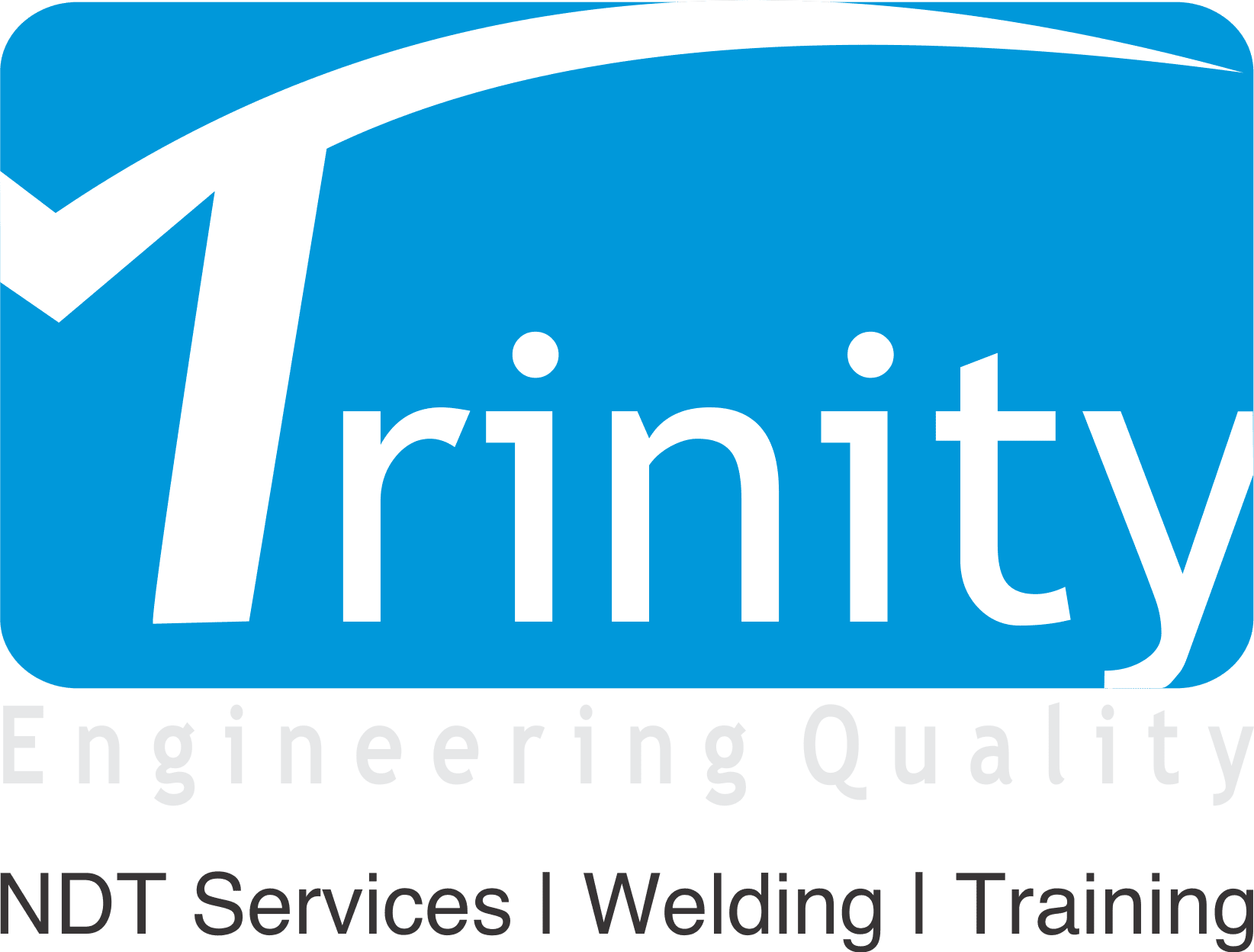Magnetic Particle Testing (MPT) Labs. Crack Detection Services.
ASNT Level III, ISO9712 MPI testing Experts. In-house, On-site Services.
NABL accredited MPT testing Lab in Bangalore. 1500+ clients. Since 2001.
Magnetic Particle Testing. Crack detection Services in Bangalore. NABL Accredited MPI Lab. ASNT, ISO9712 Certified personnel.
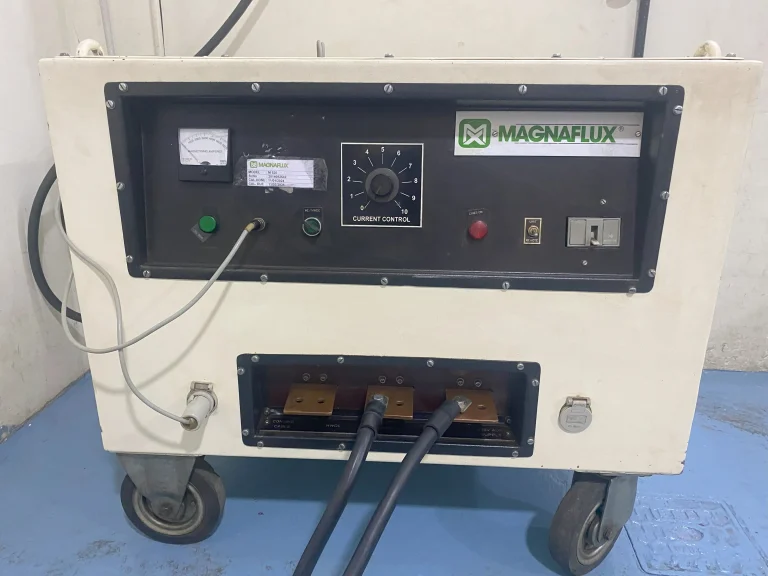
‘Trinity NDT WeldSolutions Pvt. Ltd – Testing Lab’ provides Magnetic Particle Testing services in Bangalore. MPT is a reliable method for crack detection on ferrous metals. Also known as ‘Magnaflux’ crack inspection. The method detects surface and subsurface cracks in Iron, nickel and cobalt alloys. An ISO17025 NABL accredited lab in India. ASNT, ISO9712, NAS410 certified inspection personnel. Our aerospace MPI services are covered under NADCAP accreditation for aerospace applications.
MPT test center, accredited from NABL, Delhi as per ISO17025:2017. As a result, test reports acceptable from Government agencies, defence organizations, OEMs and third party inspection agencies. Complete range of techniques to test fasteners, welds, castings, forgings, plates and virtually any material that is ferro-magnetic. Check our NABL scope.
Complete range of MPT techniques at lab in Bangalore. Permanent Magnet, Electromagnetic Yoke, Head shot, Coil, Central Conductor and Prod type. Wet, fluorescent and non-fluorescent. AC, DC and HWDC currents. Procedures meet ASME E1444, ASTM E709 and ISO9934 standards. Inspectors capable of MPT testing as per AWS D1.1, API 1104, other specifications.
Service location in and around Bangalore. Onsite to number of customers in Hosur and Mysore. Onsite MPT testing limited to using portable electromagnetic yoke and prods. NDT Level II Inspectors works at various project sites (on-site testing) across India. Inspection team mobilise equipment, inspectors onsite.
Equipment, procedures and personnel qualifications meets ASTM E709 and ASTM E1444. Established in the year 2001, Trinity NDT is the largest independent NDT service lab for MPT testing in Bangalore, India. Equipment for measuring magnetic field strength (flux) in Gauss and Tesla. Expert personnel to perform De-magnetization to remove residual magnetism.
In-house ASNT and NAS410 Level III for magnetic particle inspection. Gives, consulting on procedure preparation and approval. Training, certification of personnel for MPT Level I, II as per SNT TC 1A and ISO9712 schemes.
If you need a reliable lab for magnetic particle testing services in Bangalore, ask for quotation. Serving 1500+ customers across India. Experience the fastest NDT services. Contact us today.
NABL, NADCAP Accredited MPT testing Lab
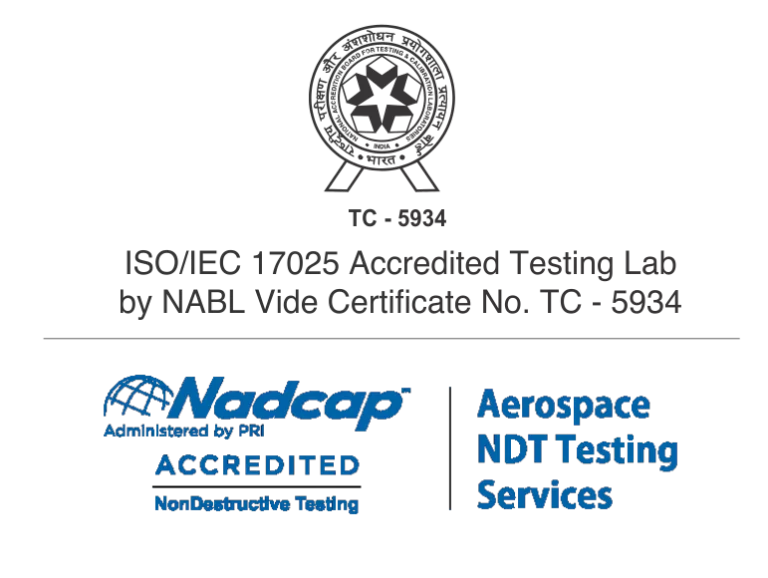
A unique NDT lab for Magnetic Particle Inspection serving in, around Bangalore and Hosur. Equipped with MPI bench units, yokes, and prods. Serves within Peenya and onsite at customer works anywhere. Certified MT Level II inspectors as per ASNT and ISO9712. MPT inspection procedure monitored from in-house ASNT NDT Level III. Ensures adherence to ASTM E709, ASTM E1444, ISO 9934 standards as the case may be.
NABL Accreditation as per ISO17025:2017 and ISO9001:2015 covers scope for magnetic particle inspection. MPT Procedures are approved from ASNT Level III as per ASTM E709. Machines and inspectors deliver high standards of quality. Accreditation ensures customers, supply materials worldwide without doing repeated tests, saving time and cost.
Portable electromagnetic Yoke, well-suited for on-site inspections. Offering flexibility and convenience. On the other hand, prod equipment is ideal for rough surfaces on castings and welds. For mass production, high sensitivity inspection, bench-type MPI equipment prove suitable and efficient in terms of cost and high productivity.
Employing ‘magnaflux’ powders, carrier oils, and test kits. Magnetic particle inspection (MPI) testing services are on-time and dependable. Daily control checks conducted to guarantee procedure is well-managed. Additionally, in-house ASNT NDT Level III, and NAS410 Level 3 diligently oversees each check, ensuring and affirming the accuracy of results.
Each MPT test is performed using NDT Level 3 approved procedures. Check scope of accreditation. Download NABL accreditation certificate. Aerospace MPI needs completely different approach. Aerospace testing lab equipped with fluorescent magnetic particle testing as per ASTM E1444 (all techniques) for aerospace customers. For aerospace, labs are NADCAP accredited.
With more than 20 years of expertise, we stand as the premier magnetic particle testing center in India. Our Peenya Center offers comprehensive MPT inspections, and we also provide onsite services across India.
Equipment, Techniques and Types of Currents
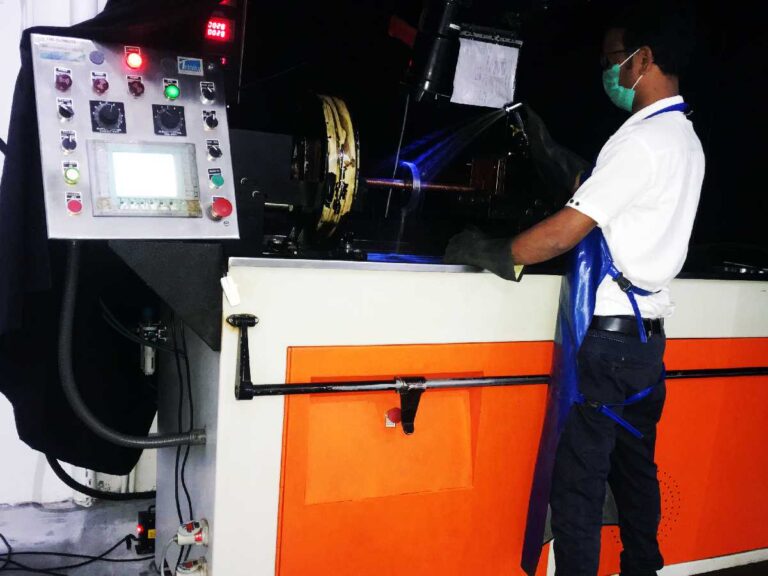
Our magnetic particle testing labs are equipped with a range of techniques to meet diverse needs. The selection of the most suitable technique for testing is determined in advance, taking into consideration customer requirements, component size, geometry, quantity, desired sensitivity, and the location of the component
- Electromagnetic Yoke
- Head Shot using bench type machines
- Coil technique
- Central Conductor
- Prod type technique
- Permanent magnets
- Dry or wet particles
- Fluorescent or Non-fluorescent
We use electromagnetic Yokes with AC and DC currents. Prod equipment with AC and HWDC. Bench type MPT equipment have all three modes of currents, ex: AC, HWDC and FWDC. Equipment up to 6000A which is quite favourable for magnetic particle testing of large castings, valves and welds.
Prod Type, AC/DC Yokes and Permanent magnet type techniques are suitable for onsite MPT testing. We use portable kits for field MPI crack testing services. Bench type equipment meets Aerospace procedures as per ASTM E 1444 and suitable for testing mass production components. The machine can produce up to 6000 Amps of current.
Inspectors Qualifications and Certifications
Lab for Measuring Magnetic Field Strength in Gauss
Magnetic Field Strength is measured in Gauss or Tesla. Here is the lab that measures magnetic field strength accurately. We have the facility equipped with digital gauss meter, Tesla meters. These equipment are accurate to meet international standards. It works on hall effect probe principle. Facility to read up to 10000 Gauss for magnets that are powerful. Can handle the component of any size at our labs.
Contact us today to get our magnetic field measuring services. Units are Gauss or Tesla.
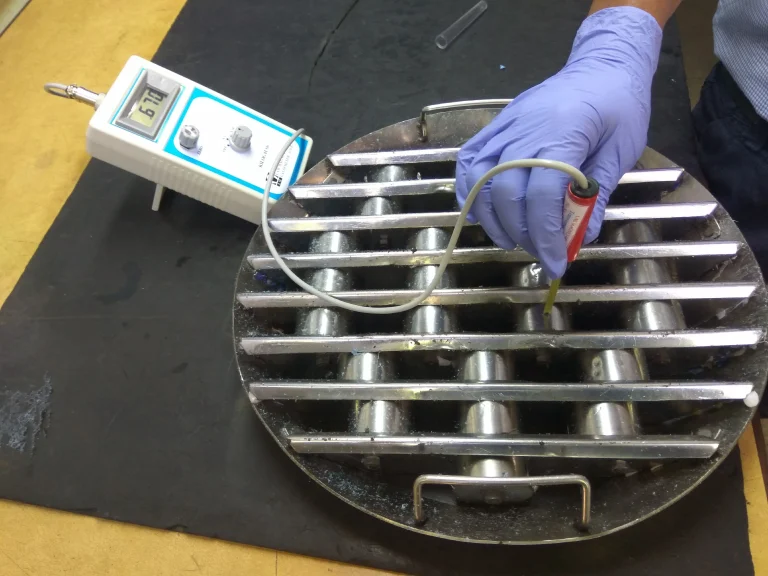
Demagnetization
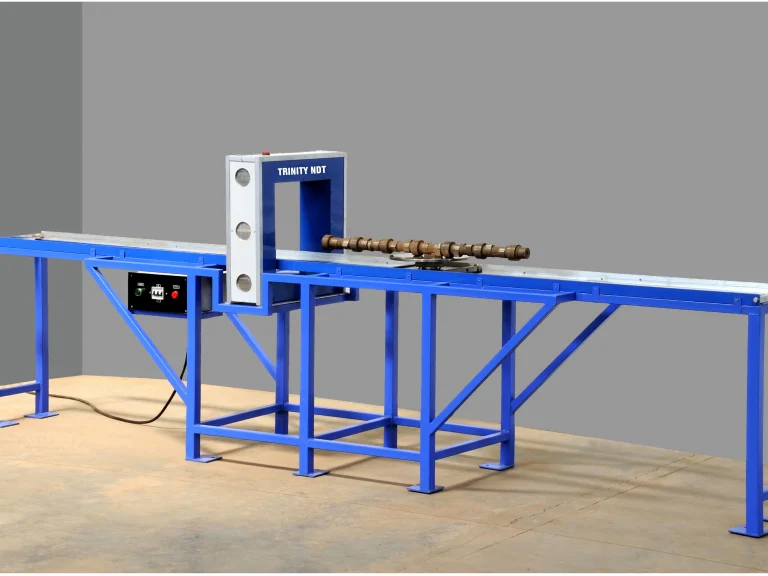
Components retaining objectionable residual magnetism pose a risk of failure, particularly those integrated into aircraft assemblies, necessitating demagnetization. Typically, magnetic fields exceeding +3 gauss are deemed unacceptable.
To address residual magnetism, demagnetization procedures are essential, requiring specialized equipment, residual gauss meters, and skilled inspectors. Our MPT facility is equipped with de-magnetizers designed to reduce residual fields to acceptable levels, typically below +3 gauss verified using calibrated instruments.
Do your shafts, bar stock, or gears exhibit excessive residual magnetism? If so, our center offers demagnetization services. Learn more about our demagnetization solutions.
Can painted and coated parts tested?
Magnetic particle inspection method can be used on painted and coated parts as well. Specifications allow up to 76 micrometer of paint thickness, where as only 25 micrometer of conductive coating such as Nickel or chromium. In any case, allowable thickness depends on specification and subject to approval from customers.
You need the remove the paint if it is within the limits. Else, it should be demonstrated to achieve the desired sensitivity or paint is to be completely removed for effective examination.
Selection - Fluorescent or Non-fluorescent Techniques
Fluorescent magnetic particle testing detects finer flaws than non-fluorescent technique. Where higher sensitivity is desired and application of part is critical, fluorescent technique is recommended. Less critical on-site inspections are performed using non-fluorescent powders and visible lights. Fluorescent technique needs, UV light, darkroom, accessories and suitable for shop floor type inspections.
Aerospace applications demands fluorescent MPT testing.
Why Choose our MPT testing services?
- NABL ISO17025 accredited lab. Globally acceptable test reports.
- Quick response service team
- Calibrated equipment, approved for Aerospace NDT standards
- High amperage to operate up to 6000A
- AC, HWDC and FWDC currents
- Prod machines for on-site
- coils, solenoids, central conductors
- UV lights that meets aerospace specification ASTM E3022
- Inspectors with MT Level I, II certification as per NAS410, ISO9712 and ASNT SNT-TC-1A
- In-house ASNT NDT Level III.
- Skilled inspector that got trained at our NDT training division. Check about our Magnetic Particle Testing courses.
- Serving in and around Bangalore and onsite at plants across India.
- Sales of MPI yokes, prods, powders, carrier oils and consumables.
Our NDT Services & Consulting
Magnetic Particle Testing - A Guide
Principle
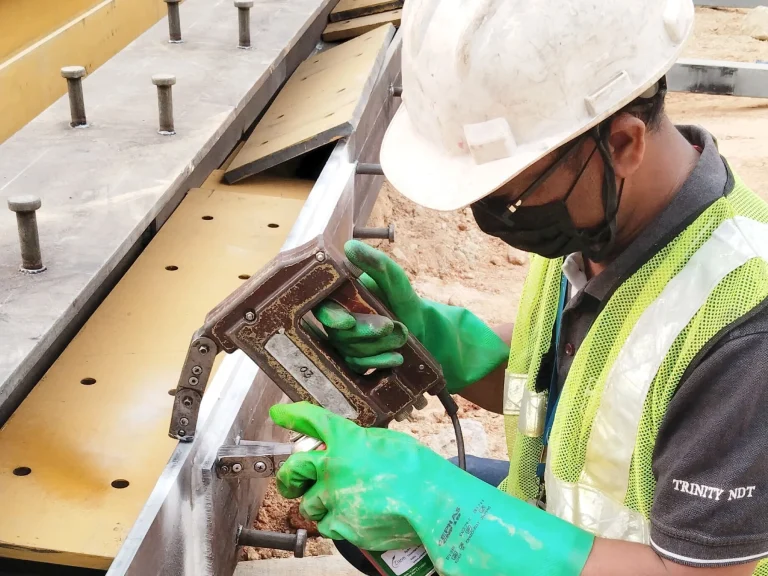
This method works on working principle of ‘magnetic flux leakage’. This method allows detect flux leakage due to flaws. Flux lines allowed to travel in ferro-magnetic materials using various techniques cited above. If there are cracks or other flaws, flux lines breaks and leakage field exists. If there is a leakage flux there could be a flaw. Apply Magnetic medium (dry or wet) while magnetizing so that medium forms an indication at the leakage area. Using suitable lighting such as fluorescent, indications are finally interpreted and evaluated. The method needs qualified and certified MPT Level II inspectors to perform and interpret the results.Finally, Interpret and dispose the material.
Sometimes based on application of part, de-magnetization may be necessary to remove residual magnetism.
For which materials is magnetic particle testing is suitable? It is most suitable for any magnetizable material such as Iron, Nickel and Cobalt alloys. Virtually, any thing that can conduct magnetic flux lines is a material for this testing.
For which material magnetic particle inspection is NOT suitable? Except the above stated alloys, it is not suitable non ferrous materials such as Al, Cu, Mg and Austenitic stainless steels. MPT for ferritic and martensitic stainless steels is possible.
MPT testing applications
Magnetic particle testing is suitable to inspect castings, forgings and welds. In addition, the method is even acceptable for steels in as cast, as forged and as machined condition. Further, this gives satisfactory results during in-service inspection of shafts and gears to find fatigue cracks. Starting from bolts, and washers to giant ship structures, aerospace structures are easily tested using this method.
Procedure
It is rather simple to carry magnetic particle testing. Brief steps and procedure is below.
- Prepare the part and clean the surface
- Dry the part, if needed
- Introduce magnetic field
- Apply the medium
- Allow the particles to accumulate
- Find the cause of indication and record
- Demagnetize if required
- Post clean and apply rust preventive oil.
Codes and Standards
There are various codes and standards in Magnetic particle testing. ASTM, ISO, BS and EN standards helps in developing NDT procedures.
Following is the brief list of few standards:
- ASTM E709 – Standard Guide for Magnetic particle testing
- ASTM E1444 – standard practice for MPT used for Aerospace NDT applications
- ASTM A275 – Practice for Magnetic Particle Exam of Steel Forgings,
- ASTM A456 – Specification for Magnetic Particle Examination of Large Crankshaft Forgings
- Also NAL has released NDT specifications/procedures for Indian aerospace and defense
Comparision of Penetrant and Magnetic particle testing methods
Penetrant testing (PT) and magnetic particle testing(MPT) are two different surface NDT methods. Though PT detect purely surface flaws, MPT can detect both surface and subsurface flaws. PT testing is suitable for any material that is non-porous where as MPT is only suitable for ferromagnetic materials. PT is time consuming and MPT is relatively quick method.
Pre-cleaning is vital step in PT, whereas it is NOT so important in MPT. Therefore, if the procedure allows, can be used on painted or coated parts as well. Both the methods are available in portable kits for site use. In both the methods, stationery machines are suitable for mass production component testing for high accuracy.
Applications
Magnetic particle testing is an NDT method for materials testing in all major industries that use ferrous materials. This includes, crack testing of steel castings, forgings, plates, weld joints and lot more. Also, has uses in inspection of pressure vessels, ships, bridges etc.,. In addition, in-service MPI testing is a reliable method for detecting cracks on rails, axles, earth-moving equipment, mill rolls, mining equipment and many more.
The flaws detectable include cracks, inclusions, pipe, laminations, bursts and flakes. They may be inherent in the raw materials or may result from welding and heat treatment. Flaws may occur in-service from fatigue and corrosion.
Detects fine fatigue cracks that are otherwise undetectable, during in-service inspection of power plants, cement plants, sugar plants, oil and gas pipelines. Suitable for surface and just below surface cracks on gears, pinions, roller shafts, chain links etc.,
Advantages
- Magnetic particle testing can detect both surface and sub-surface flaws.
- Can easily inspect parts with uneven geometries.
- Cleaning of components is not as critical as it is for some other inspection methods. Most contaminants within a flaw will not hinder detection. Can be effective even if the component is not perfectly cleaned.
- Quick method and indications are visible directly on the surface
- Painted objects also can be testing without removal of paints/coatings
- Considered low cost
- Portable inspection method
- Reliable method for detecting linear type flaws such as cracks, lack of fusion, laps and seams.
Limitations
- MPT cannot detect internal flaws
- Not suitable for non-ferrous materials
- Inspection of large parts may require special power
- Some parts may require removal of coating or plating for good sensitivity.
- Limited subsurface flaw detection. Under ideal conditions, maximum depth sensitivity is up to 14mm
- Post demagnetization and Post cleaning, needed.
- Alignment between magnetic flux and defect is important.
- Cracks that are parallel to flux direction are not detectable.
Training and Certification courses - Level I, II as per ASNT SNT TC 1A
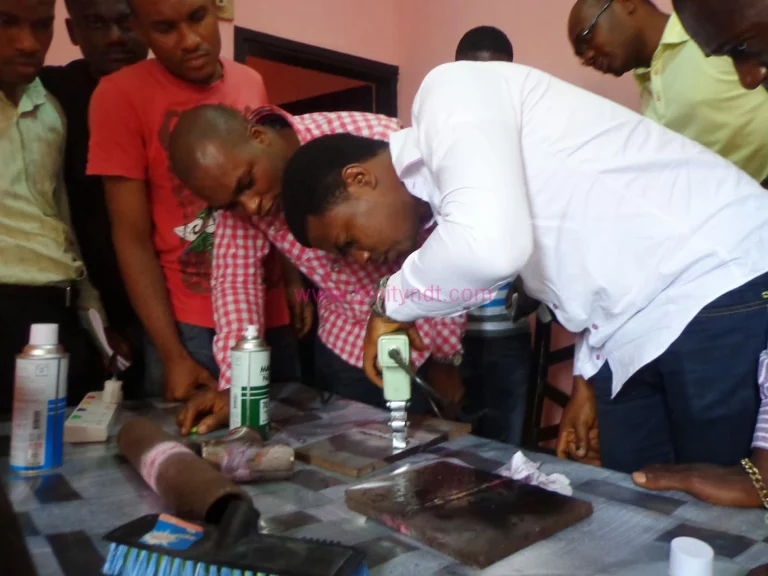
Want to learn more about Magnetic particle testing ? We advise you to register for our NDT & Welding Inspection courses. We offer NDT Level 2 courses from India’s best institute at Bangalore, India. Trinity NDT can also train and certify in other methods such as Eddy Current inspection, penetrant testing, Radiography testing, Radiography film interpretation and Visual testing .
To Check the fee, courses eligibility and training schedules. For latest updates and news about NDT developments visit Ravi Trinity NDT Blog
